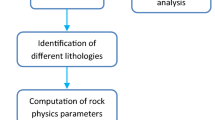Abstract
A cluster analysis methodology is developed to recover facies realizations from observed reservoir attributes. A maximum likelihood estimator allows us for identifying the most probable underlying facies using a spatial clustering algorithm. In seismic characterization, this algorithm can yield relevant geological models for subsequent history-matching studies. In history-matching procedures, it provides informative facies maps as well as starting points for further studies.
Similar content being viewed by others
References
Gringarten, E., Journel, A.G., Gundeso, R., Yao, T.: Stochastic modelling of a fluvial reservoir: a comparative review of algorithms. J. Pet. Sci. Eng. 21, 95–121 (1998)
Allard, D., Guillot, G.: Clustering geostatistical data. In: Kleingeld, W.J., Krige, D.G. (eds.) Geostatistics 2000 Cape Town vol. 1, pp. 49–63 (1999)
Bornard, R., Allo, F., Col´ou, T., Freudenreich, Y., Caldwell, D.H., Hamman, J.G.: Petrophysical seismic inversion to determine more accurate and precise reservoir properties. In: SPE 94144, SPE Europec/EAGE Conference and Exhibition, Madrid, Spain, 13–16 June 2005
Celeux, G., Govaert, G.: A classification em algorithm for clustering and two stochastic versions. Technical Report 1364, INRIA (1991)
Christie, M.A., Blunt, M.J.: Tenth SPE comparative solution project: a comparison of upscaling techniques. In: SPE 66599, presented at the SPE Reservoir Simulation Symposium, Houston, Texas, 11–14 Feb 2001
Da Veiga, S., Le Ravalec, M.: Rebuilding existing geological models. In: Proceedings of the 72nd EAGE Conference & Exhibition incorporating SPE EUROPEC 2010, SPE 130976, Barcelona, Spain, 14–17 June 2010
de Brito, D.U., de Moraes, R.J., Emerick, A.A.: The Marlim field: incorporating time-lapse seismic in the assisted history matching. In: SPE 137763, SPE Latin American & Caribbean Petroleum Engineering Conference, Lima, Peru (2010)
Dempster, A., Laird, N., Rubin, D.: Maximum likelihood from incomplete data via the em algorithm. J. R. Stat. Soc., Ser. B 39(1), 1–38 (1977)
Efron, B., Tibshirani, R.J.: An Introduction to the Bootstrap. Chapman and Hall/CRC, London (1994)
Fernandez, P.J., Ferrari, P.A., Grynberg, S.: Perfectly random sampling of truncated multinormal distributions. Adv. Appl. Probab. 39, 973–990 (2007)
Floris, F.J.T., Bush, M.D., Cuypers, M., Roggero, F., Syversveen, A.-R.: Methods for quantifying the uncertainty of production forecasts: a comparative study. Pet. Geosci. 7, 87–S96 (2001). doi:10.1144/petgeo.7.S.S87
Galli, A., Beucher, H., Le Loc’h, G., Doligez, B.: The pros and the cons of the truncated Gaussian method. In: Armstrong, M., Dowd, P.A. (eds.) Geostatistical Simulations, pp. 217–233. Kluwer Academic, Dordrecht (1994)
Goovaerts, P.: Geostatistics for Natural Resources Evaluation. Oxford University Press, New York (1997)
Han, M., Zhao, Y., Li, G., Reynolds, A.C.: Application of EM algorithms for seismic facies classification. Comput. Geosci (2010). doi:10.1007/s10596-010-9212-4
Hu, L.Y.: Gradual deformation and iterative calibration of gaussian-related stochastic models. Math. Geol. 32(1), 87–108 (2000)
Journel, A.: Geostatistics for reservoir characterization. In: SPE ATCE, New Orleans, USA, SPE 20750, 23–26 Sept 1990
Lahiri, S.N.: Resampling Methods for Dependent Data. Springer, New York (2003)
Le, G., Loc’h, Galli, A.: Truncated plurigaussian method: theoretical and practical point of view. In: Baafi, E.Y., Schofield, N.A. (eds) Geostatistics Wollongong ’96, vol. 1, pp. 211–222. Kluwer Academic, Dordrecht (1996)
Le Ravalec-Dupin, M., Hu, L.-Y., Roggero, F.: Rebuilding and recalibrating an existing reservoir model to dynamic data. Earth Sci Front 15(1), 176–186 (2008)
Le Ravalec-Dupin, M., Noetinger, B., Hu, L.-Y., Blanc, G.: Conditioning to dynamic data: an improved zonation approach. Pet. Geosci. 7, S9–S16 (2001)
MacQueen, J.B.: Some methods for classification and analysis of multivariate observations. In: Proceedings of 5-th Berkeley Symposium on Mathematical Statistics and Probability, pp. 281–297. University of California Press, Berkeley (1967)
Nelsen, R.B.: An Introduction to Copulas. Lecture Notes in Statistics, vol. 139. Springer, New York (1999)
Nordman, D.J., Caragea, P.C.: Point and interval estimation of variogram models using spatial empirical likelihood. J. Am. Stat. Assoc. 103(481), 350–361 (2008)
Author information
Authors and Affiliations
Corresponding author
Rights and permissions
About this article
Cite this article
Da Veiga, S., Le Ravalec, M. Maximum likelihood classification for facies inference from reservoir attributes. Comput Geosci 16, 709–722 (2012). https://doi.org/10.1007/s10596-012-9283-5
Received:
Accepted:
Published:
Issue Date:
DOI: https://doi.org/10.1007/s10596-012-9283-5




